A dark side brighter than expected - a reappraisal of composite dark matter
At the end of my talk at HiveFest, I showed some scientific results about dark matter. I mentioned that they were related to the topic of one of my future blogs, and to that of one of my future scientific publications. This publication was released on the arXiv last week. Correspondingly, a blog is due!
Today I discuss composite models as potential solutions to some of the conceptual and practical limitations of the Standard Model of particle physics. For general information about the problems of the Standard Model, please see here and there. In the present blog, I only discuss what composite models are, and I obviously provide a brief recap about dark matter. Then I enter the main topic of the blog: my last publication about composite dark matter.
In this article, we found that composite dark matter scenarios may be easier to observe than expected. Whereas experiments targeting dark matter direct detection (I explain what they are below) were known to be mostly insensitive to such scenarios, these conclusions relied on a too simplistic description of the theory. We instead demonstrated in our article that future experiments have a chance to observe some composite dark matter models.
If you are pushed for time, please consider going directly to the summary given at the end of this blog. Otherwise, please buckle up and enjoy some particle physics.
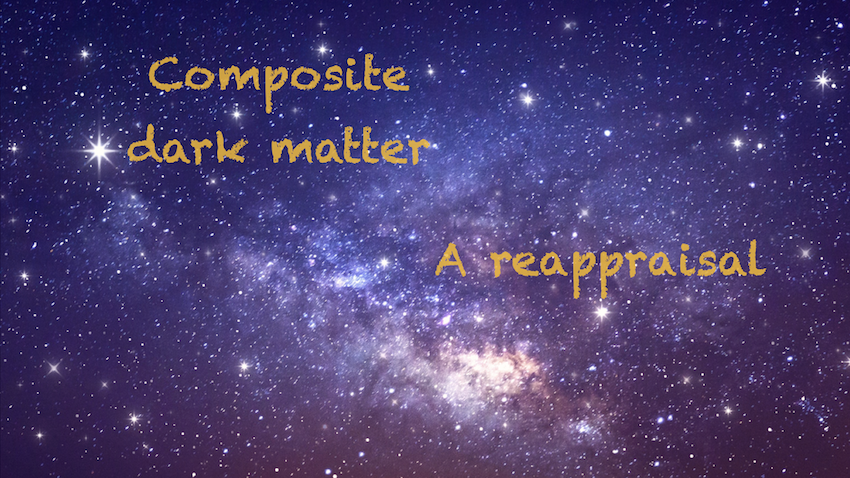
[Credits: Original image from Andrea Stöckel (public domain)]
Composite models for new phenomena?
A composite theory is a theory in which new fundamental building blocks of matter are postulated, and these building blocks are strongly interacting with each other. Consequently, they form composite particles. At energy scales currently probed, for instance at CERN’s Large Hadron Collider (the LHC), these fundamental particles are too heavy to be observed. However, there is a vast zoo of composite objects that are potentially lighter, and thus reachable at particle colliders.
This idea is not new, as it is the one that lies behind the theory of the strong interaction, one of the three fundamental forces described in the Standard Model. In this last case, quarks (the fundamental building blocks of matter) form composite particles called hadrons (like protons, neutrons or pions). Designing high-energy experiments for more than 50 years allowed us to break hadrons, and get some insights on their quark content.
A similar story holds for composite models (assuming that nature picks them as its favourite option for physics beyond the Standard Model). However, the energy needed to break the composite objects and to access their internal structure has to be much larger than any energy regime that can be reached in current experiments.
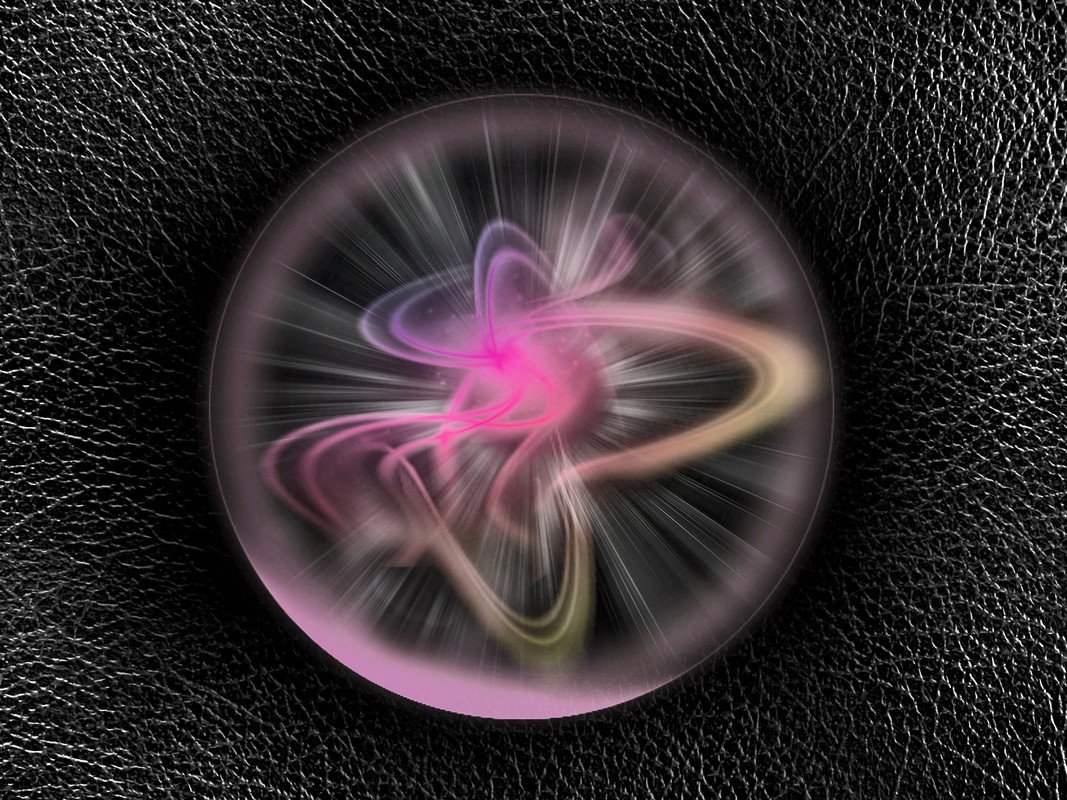
[Credits: ThomasWolter (Pixabay)]
To repeat, composite models have the particularity to predict a vast zoo of new particles that are combinations of a small set of fundamental particles. A few of those states could be very light, and thus potentially observable at the LHC. The lightest of those states is the Higgs boson, which is allowed by data to have a composite origin. Note that on the other hand, there is no proof (yet?) that the Higgs boson is composite. It is just a possibility that has not been ruled out (yet?).
In addition to the Higgs boson, other light states may be around the corner, and accessible at the LHC. One of them could be a good candidate for dark matter (assuming that dark matter is associated with a particle; see below), and another could be a mediator linking dark matter to the Standard Model. This mediator is generally related to the top quark, the heaviest of all elementary particles known.
The reason behind this new particle configuration is that composite models encompass a mechanism called partial compositeness, that is needed to explain the large mass of the top quark. This somewhat promotes the top quark, which then plays a special role in the theory.
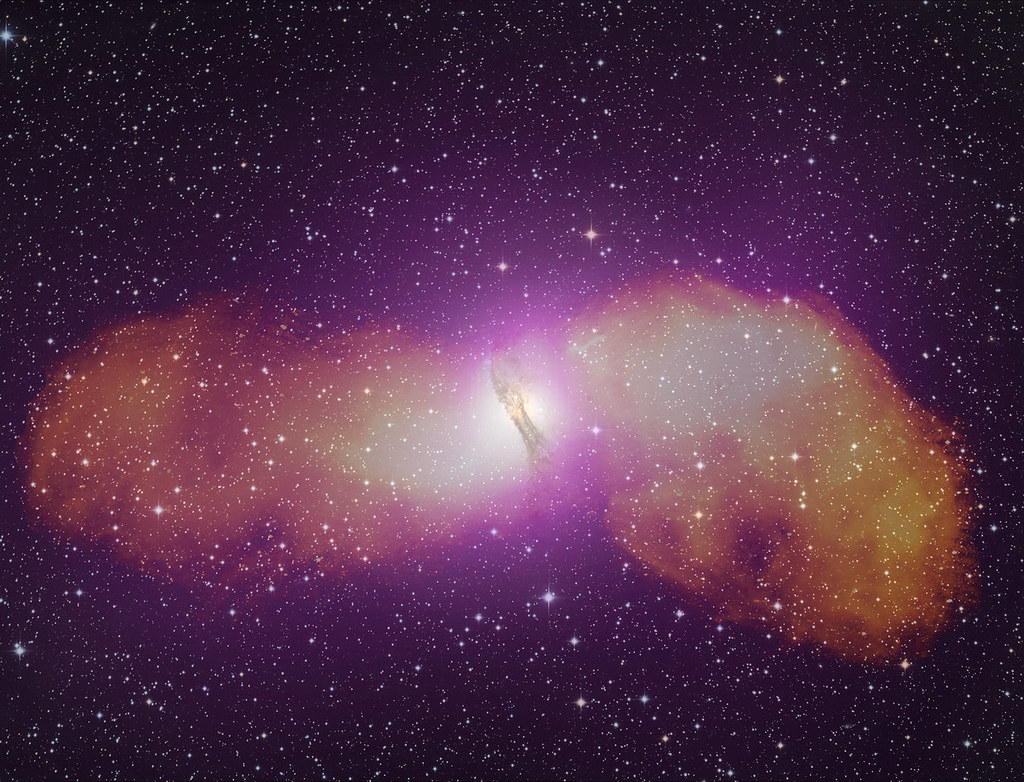
[Credits: NASA (CC BY 2.0)]
Dark matter and how to search for it
Dark matter consists of a very popular topic in particle physics and cosmology today, as it is probably one of the most elusive substances for which we ever searched.
The origins of dark matter can be found in discrepancies between theory and data in the context of the rotation motion of stars in galaxies. Fritz Zwicky (and Vera Rubin a bit later) found that stars were moving too fast compared with predictions of classical mechanics. Two options are thus left: either some mass is invisible (i.e. dark matter) or classical mechanics needs to be modified at large distances. We adopt the first option.
Secondly, we can imagine that dark matter must have a particle physics explanation. In other words, there must be a particle that can play the role of dark matter. That is our second assumption. The good news is that these two assumptions provide an explanation to several cosmological observations: the cosmic microwave background, the formation of the large structures in the universe, gravitational lensing, etc.
I won’t enter into all these details, as they were already provided in many of my earlier posts. What is important to remember is that dark matter allows us to solve many puzzles in cosmology, provided that we assume that the standard model of cosmology is valid.
This model, although far from being perfect, is currently the simplest explanation for observations. This being said, we must keep in mind that it has defects, and may only be an effective vision of what physics truly is. It consists however of a good starting point.
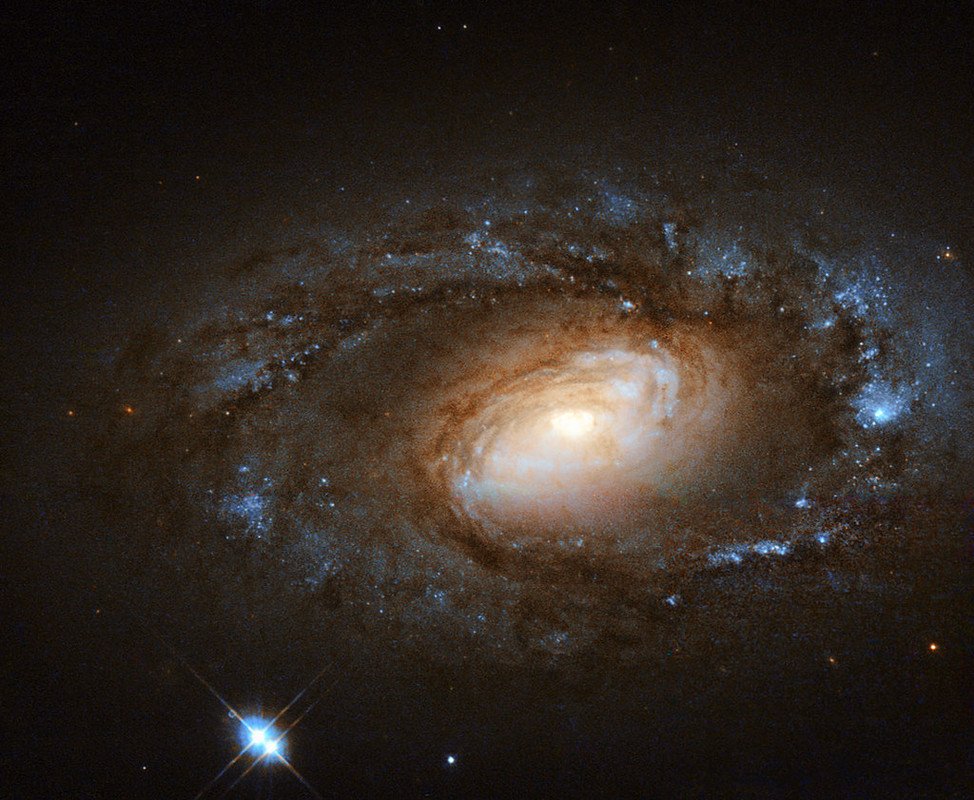
[Credits: NASA (CC BY 2.0)]
With all assumptions made so far, we can calculate the amount of dark matter in the universe for a given model, and verify that it matches observations. Moreover, we can investigate to what extent signs of dark matter can be found in cosmic rays, accelerators or in direct detection experiments.
In the first case, we analyse the amount of cosmic rays reaching Earth, and we investigate if they feature properties compatible with that emerging from the annihilation of dark matter particles elsewhere in the universe. In the second case, we accelerate high-intensity beams of particles (like at the LHC at CERN) and smash them. The associated large amount of energy allows us to produce new particles (provided they exist), and in particular dark matter. Finally, in a direct detection experiment, we try to observe dark matter particles going through our planet and hitting atomic nuclei localised in huge detectors.
For now, no sign of dark matter has however been observed, so that all means to find dark matter only led to constraints on existing models.
In the rest of this post, we make a third assumption: dark matter has a composite origin. In this case, it connects with the Standard Model through interactions with a mediator particle and the top quark, as discussed earlier in this blog.

[Credits: NASA/ESA (CC BY 2.0)]
A realistic description of composite dark matter
In a previous blog, I have discussed how my collaborators and I investigated how composite dark matter was a viable option, in light of existing constraints from cosmic rays, direct detection and the LHC. It turned out that viable scenarios predicting the right amount of dark matter required a strong coupling of the dark matter to the Standard Model, and that particle colliders were the only way to have a chance to discover dark matter in the next decades.
In the follow-up article (to which this blog is dedicated), we studied the composite dark matter paradigm further, and we demonstrated that the above conclusions were too strong.
Composite dark matter models can be simply constructed by taking the Standard Model, and adding a dark matter and a mediator particle to it. Then, we need to allow the dark matter to interact with the mediator and the top quark. This is however too simplistic. Generally, composite scenarios predict that the theory should include not only one, but possibly more than one mediator, with orthogonal properties.
This is the path that we have followed in our last article: we took the previous model and added a second mediator with orthogonal properties (I won’t enter into detail here; however feel free to ask questions about this if you are interested).
Does it change a lot? Well, yes! The most dramatic impact is that the rate at which a dark matter particle could hit an atomic nucleus localised on Earth gets enhanced, by virtue of the new particle and its interactions. This means that dark matter direct detection experiments now have a chance to observe composite dark matter. Let’s illustrate this by a figure.
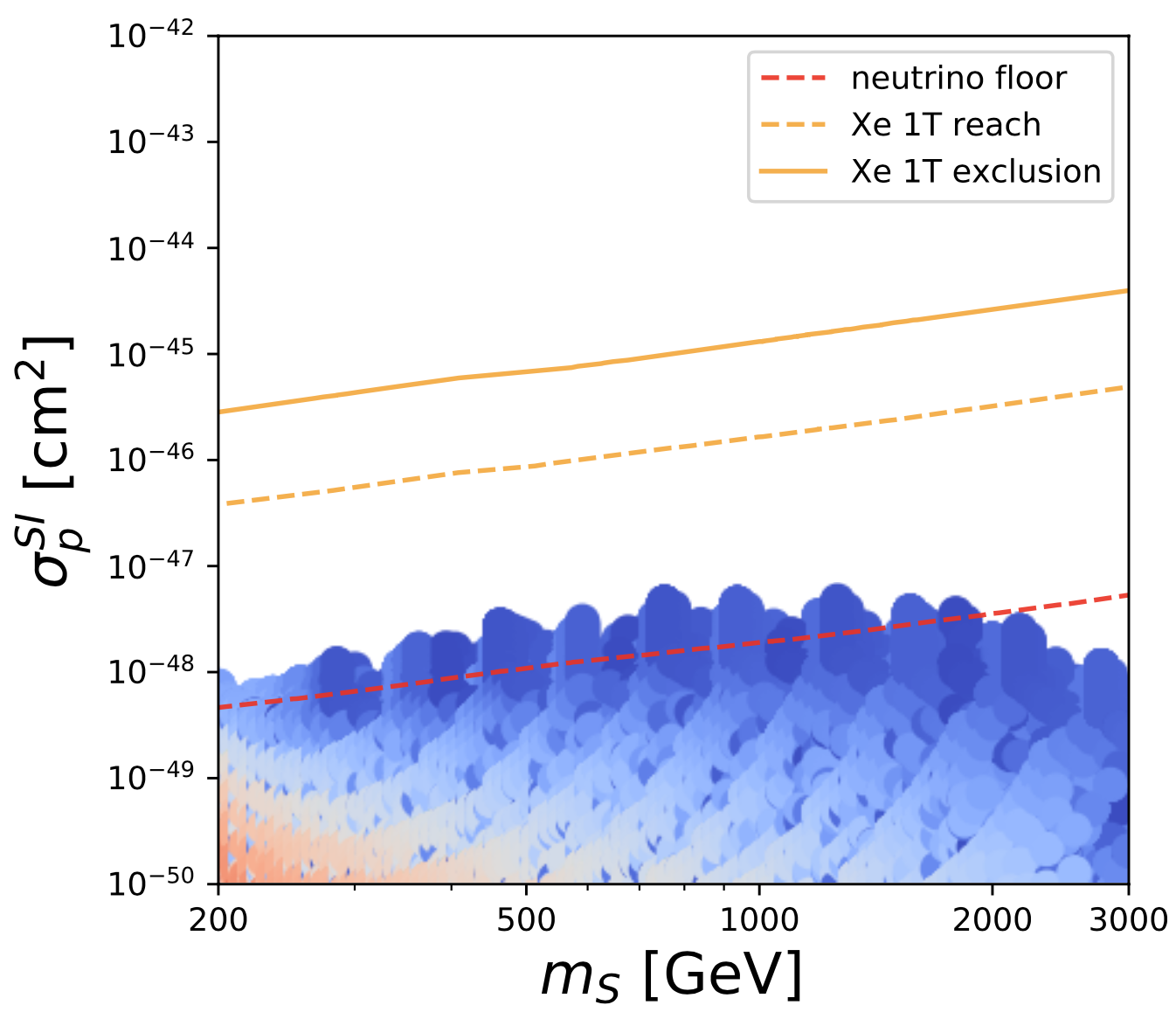
[Credits: arXiv:2209.13093 [hep-ph]]
In this figure, we report the rate at which dark matter can interact with a proton (one of the particles composing atomic nuclei). The rate is shown on the Y-axis, and we display the dark matter mass on the X-axis (the units are in GeV, with 1 GeV being the proton mass). All coloured points correspond to a viable scenario, predicting the right amount of dark matter.
The solid orange line is the current limit from dark matter direct detection experiments. Any scenario above this line is excluded as it would correspond to a signal impossible to miss (and no signal has been found). The dashed orange line corresponds to the expectation of the future upgrade of the Xenon 1T experiment. Anything above the dashed orange line could be observed or excluded very soon.
What is important is the red dashed line. It represents the so-called neutrino floor. Below this line, dark matter events are too rare to be observed from the flux of neutrinos hitting the detector. We observe that many composite scenarios lie below this line, so that future dark matter direct detection experiments have no chance to observe them.
However, we also observe that some scenarios lie above the red line. This means that we actually have options to observe a signal in future experiments. And that’s pretty good news, as this means that we have a new handle on composite dark matter models!

[Credits: geralt (Pixabay)]
Summary: a composite dark side brighter than expected
Composite models are a class of theories beyond the Standard Model of particle physics that assume that there are new fundamental particles (still to be observed) that are sensitive to a new strong interaction. This allows them to form a variety of new composite particles that could be observed in present and future experiments.
Among those new particles, models often predict a particle (that I called a mediator) connected to the top quark of the Standard Model. Such a particle is needed to explain the large mass of the latter. In addition, the zoo of composite particles can also include a particle that could play the role of dark matter, and that could leave signatures in particle accelerators like the LHC, cosmic rays or dark matter direct detection experiments.
In my previous work, we have explored the viability of the above scenarios, and have found that dark matter must be strongly coupled to the mediator and the Standard Model. Moreover, we have shown that the only way to observe its signs would be at particle colliders.
A few weeks ago, with my collaborators we explored further those setups, but in a situation closer to reality. In general, composite models feature several mediators relating dark matter to the Standard Model with different properties.
This more realistic description allowed us to show that next-generation dark matter direct detection experiments can be sensitive to such scenarios, and thus have some potential to observe dark matter in the future. Therefore, composite dark matter may not be as hidden as initially thought.
I stop here for today, and I hope you enjoyed reading this blog as much as I enjoyed writing it. Feel free to ask questions, comment on the text and give feedback in the comment section below. Have a nice end of the week!
https://twitter.com/BenjaminFuks/status/1577999567265714177
The rewards earned on this comment will go directly to the people( @lemouth ) sharing the post on Twitter as long as they are registered with @poshtoken. Sign up at https://hiveposh.com.
Thanks for your contribution to the STEMsocial community. Feel free to join us on discord to get to know the rest of us!
Please consider delegating to the @stemsocial account (85% of the curation rewards are returned).
You may also include @stemsocial as a beneficiary of the rewards of this post to get a stronger support.
Curious about what are the next steps?

!1UP
That's a super good question.
In fact, for that kind of models, we captured the main phenomenological consequences (from the dark matter standpoint) with our next-to-minimal setup with two mediators. I thus consider moving to other topics for what regards studie of composite models. I plan to still follow the path of non-minimality, but in order to explore the impact of new signals not covered by the experimental programme at the LHC. This will allow us to make sure the LHC is exploited in the best possible way.
Ergh.... I think that you just selected the next topic about which I will write (as I have results already published in that direction) :)
hahaha so the next steps are already well developed!
Well... that's probably true :D
You have received a 1UP from @gwajnberg!
@stem-curator, @vyb-curator, @pob-curator, @neoxag-curator, @pal-curator
And they will bring !PIZZA 🍕.
Learn more about our delegation service to earn daily rewards. Join the Cartel on Discord.
PIZZA Holders sent $PIZZA tips in this post's comments:
@curation-cartel(17/20) tipped @lemouth (x1)
Learn more at https://hive.pizza.
Wow, what a create resource. Thank you for sharing ☺️
You are welcome!
Cheers!
I so much admire your writing and how you explain everything in details and step-by-step. Physics is such an interesting world.. I enjoyed it so much in my early years in the university but as time progressed, our courses were narrowed to biology and chemistry based courses but physics has still remained a lovely course for me.
I have always looked forward to gaining more knowledge in this field and from your blogs I have gained a better knowledge of particle physics. Thanks so much for the great job, Sir.
Thanks a lot for this very kind message and for having read my blog. It is truly appreciated.
I hope my blogs are understandable enough so that anyone could follow and learn a few things (even if this only consists of parts of the blogs). Don't hesitate to let me know if parts are too hard or not enough detailed. Sometimes, I just get too excited to notice that I should slow down ;)
Cheers!
You're welcome. The contents are very clear and understandable. Many thanks Sir.
I am glad to read this!
Cheers!
This is what I like about theories of this type, in which one seeks to explain events that are of great curiosity to many, but still not fully understood by the vast majority.
Seeking to explain how particles, some of which are not yet certain to exist, interact in -presumably- invisible matter?
Mentally thinking about this requires not only a knowledge of matter but a very advanced degree of abstraction?
I still wonder if it will ever be possible to have an answer that is correct and can satisfy everyone regarding the origin of the cosmos, of the universe, of what inhabits it. Do you think there will ever be a concrete answer?
This is precisely what we do when we study new phenomena in particle physics. We design new theories addressing one or the other problems of the Standard Model. Once the theory has been designed (we have guiding principles for this), which means that we can write the associated equations, then we can use it to make predictions. And next, in a second step we can compare predictions with data. On the other hand, we can also predict what future experiments not existing yet should be able to do to discover new things.
The answer may be correct in some domain.
For example, there is no need to use special relativity to describe the motion of a car. Newtonian mechanics works fine. However, Newtonian mechanics does not work to describe the motion of particles traveling close to the speed of light. This does not make Newtonian mechanics incorrect. It is just that we cannot use it when objects move too fast.
We can say the same with the Standard Model. At low energies, it works fine. At higher energies, we need to consider an extension of it (whose effects at low energies are negligible).
Does it clarify?
Of course it is. Much more clearly, it is a matter of matching theories to the factors being studied, or seeing if the elements being studied, and the factors involved in a particular event fit a certain theory and can be used.
Using (logical, abstract, and more) thinking as a basis for everything... Interesting. Thank you for your response.
It is indeed a virtuous circle: experiments -> observations -> concepts -> modelling -> predictions -> experiments -> ...
You are welcome!
Hello @lemouth,
Another blog that lets us inch forward with you as you explore the possibility (likelihood) that dark matter exists. I believe the piece introduced in this blog is the second mediator with 'orthogonal' properties (had to look that up).
I don't have a question. Or, rather, I have a lot of fuzzy questions. The best part about this is, as you introduce new parts of this puzzle on the search for dark matter, the scheme of your search makes approximate sense because you've already given us a foundation (vocabulary and an overall idea of where you believe you are going).
Thanks for taking us further into the universe of particle physics. As always, a mind-opening experience, quite distinct from anything else I do in a day.
Regards and appreciation...
Hi AG,
Thanks for passing by and your very kind message!
Every once in a while, I must indeed go back to the topic of dark matter. I cannot change my inner nature ;)
I would be curious to hear them. Please :)
Cheers, and have a nice week-end!
I don't have specific questions. I understand the general idea (thank you for that) of your search. I understand why you need mediators. You are reaching for that ever- elusive entity, dark matter and you need to find the path, the link.
It's all very fascinating. Know that when there is news about physics now, I pay attention. I never did before, because it was beyond me. But I'm in the conversation. Just can't contribute anything.😇
Regards, AG
Aaaah ok. I thought you had plenty of little things you wanted to me think about (which I like to do ;) ).
Anyway, week-end time! Time for music now (with the little one). See you later (this was a quick message "in passing").
Congratulations @lemouth! You have completed the following achievement on the Hive blockchain and have been rewarded with new badge(s):
Your next target is to reach 14500 replies.
You can view your badges on your board and compare yourself to others in the Ranking
If you no longer want to receive notifications, reply to this comment with the word
STOPCheck out the last post from @hivebuzz:
Hi @lemouth ! This was an interesting read as always. I saw the Hive community project made headways after i had to take some time off being online. A lot has happened over the past months of which losing my dad was the most impactful. I've now had to fill in his shoes and cater for my siblings and mom. I will be posting on a more frequent basis henceforth. I however see that you haven't posted for some weeks. I hope all is well with you? Cheers!
I was super busy for the last 3 months, especially work-wise. I was expecting things to get calmer several times, but each time something else popped up. Now, I must also face unexpected and severe personal events, which delays a come-back once more. Hopefully, I will however be able to interact again with STEMsocial community members (both on their blogs and mine).
Cheers!
I am so sorry @lemouth. I worried there might be difficulties in your life that prevented you from engaging. Whatever the severe event is, I hope it resolves well and quickly.
With friendship and concern
AG
It is kind of resolved, but not fully. In fact, we know that we will have to wait for months before the problems get fully settled. However, the worse is now behind us, so everything is good.
Cheers, and happy new year!
🌸🌸🌸🌸
We have seen that you have previously supported proposals for the improvement of Hive.
We would love to have your support in our proposal that seeks to add a new tool to the Hive environment that will help ensure that your content continues to prioritize quality and above all originality.
You can vote here:
Peakd
Ecency
We would appreciate your support, criticism, and collaboration. Thank you for considering this proposal.
Nice one there love your writng
Thank you for the nice compliment. I should resume writing again, but lack of time is killing me :)
I pray u get some time to continue with this talent
Me too me too ^^
Hi @lemouth
Is StemSocial still operational?
Thank you.
~ Chris Rice
Open Source : D.Buzz
Yes it is! Curators are still very active, as can be seen from the @stemsocial account. I am just the only one stuck in a warp zone of duties.
Ah okay..
May I kindly know if your team already has its own front-end? I appreciate the time you've taken to reply.
Posted via D.Buzz
No we don't, but I have plans (just no time to deploy them with @mintrawa).
Would you be interested in running a fork of D.Buzz , once we #OpenSource?
Posted via D.Buzz
To be honest, I don't know at this stage.
HI, @lemouth I just came by to say thank you for voting for my introduction blog :)
My pleasure :-)
Hey @lemouth, how are things. It's been so long since you've posted last posted. Always enjoyed your scientific writings! Hope you're doing well :)
Hi @michelmake. Thanks for passing by. I am overly busy for more than a year, delving in scientific projects, teaching duties and teaching administration. I have hence almost zero time for myself, and consequently no time to write or engage on Hive. I hope for a change soon, but this is something I hope for a while actually. I will thus forbid myself to promise anything. However, I pass by regularly (actually every day), and I always answer personal messages.
In fact, there is also a little other thing. The small amount of time I dedicate to Hive for a few months is shared with @gotgame, @mobbs and @gentleshaid. A STEMsocial frontend/app is being developed :-)
The bottom line is that everything is fine. So don't worry (and thanks for asking)! What about you? How are you?
I can testify that our particle physicist is totally fine. Just busy with those tiny stuff :)
Haha great! Happy you keep an eye on fellow hiveans :D
They are closely watching my back :)
Didn't knew you were involved on developing/contributing for development of a frontend... interesting. Have to spend some more time later, checking this.
Just contributing my own quota to ensure that final product comes out fine. Wish I could tag the real developer but can't seem to recollect his handle right now.
No worries. Thanks for that.
I still hope to find some time during the winter break to write a proper post with news. However, at this stage it is just a hope ;)
I know the feeling... the mindset is a fricking tetris of dispositions.
Not so tiny... Top quarks are massive, in particular ;)
I figured it might have been related to time. Good to hear all is good! I'm just trucking on. Lately a lot more active here again after some quieter times. That STEMsocial project sounds exciting. Is there a way to keep in the loop of this or even contribute in some form?
I should find a way to go faster, close to the speed of light so that I could benefit from time dilatation ;)
Well if there’s one man here ok hive who could figure that out… 😅
lol :-)
Not much of a physicist here, but wow, that is a brain twister reading through all that. Pretty interested but way over my head, appreciate the content to learn more about all this though. Thanks!
You are welcome. I still hope to find time to blog again. It is complicated, but who knows... ;)
I've still got a lot of work to do to understand physics at this level.
I'm reading an Einstein biography. He rejected the concept of the ether, but later thought that space had to have properties. Would dark matter be related to these postulated properties?
Hi!
Dark matter is part of what is coined the Standard Model of cosmology. Therefore, it impacts the properties of the universe. But this is not the only unknown ingredient. There is also dark energy that is itself responsible for the expansion of the universe. And the two can be fully unrelated, or related (there are some constructions where they are). In short: we don't know (which is the reason why it is interesting)
I hope my answer clarified a bit. Otherwise, feel free to come back to me.
Cheers!
Thanks, your clarification helped a lot!